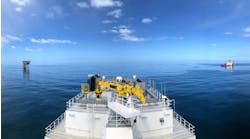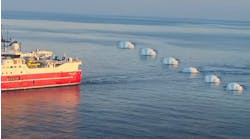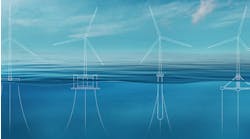Mario Zamora
Douglas Simpkins
M-I Swaco
Visualization technology has evolved into an important geological and geophysical tool to view and interpret seismic data, 3D logs, geocellular models, grids, horizons, and well placements. A recently developed software system permits interactive 3D visualization of the inside of a virtual wellbore while downhole drilling hydraulics and related conditions can be examined.
Early applications focused on well placement in complex reservoirs, and directional drilling to control well tortuosity and avoid collisions on multi-well platforms. More recent applications use 3D visualization to address drilling problems and link drilling operational data to earth models. Countless other drilling prospects could exist, especially considering that “making hole” occurs out of sight, miles below the earth’s surface.
The software exploits additional drilling visualization opportunities inside the wellbore in a more natural view for most drillers, whether on the rig floor or in the office. Simulated downhole conditions can be critically examined while navigating the well from surface to TD using a standard PC and a joystick. This capability is useful for interpreting large data sets, mitigating drilling problems, training, and maximizing collaboration among multi-disciplinary teams and some drilling teams separated by a common language. It also has placed downhole modeling under the microscope and helped highlight important areas where renewed effort is required.
At this time, the wellbore visualization software focuses on drilling fluid hydraulics, an important topic selected for several reasons, including the following:
- Hydraulics is central to the safe, economic, and efficient drilling of all wells and a critical concern for deepwater, HTHP, and highly directional wells
- Hydraulics is the primary cause and/or the solution of many common drilling problems
- Drilling personnel can have difficulty visualizing true downhole hydraulics behavior
- Step improvements in hydraulics simulation software have provided better insights into downhole behavior
- Video images captured through transparent laboratory flow loops have been effective in changing industry views on hole cleaning and barite sag
- Hydraulic parameters lend themselves to visualization.
Visualization involves the computer processing, transformation, and graphical display of data to facilitate its interpretation. The ability to manipulate digitally generated images is a distinct advantage. However, conventional video can play a key role in visualization, especially when processes and physical objects of interest are neither well defined nor well understood.
The successful evolution from video to visualization by other industries, such as the medical field, suggests that similar opportunities exist for drilling.
Downhole video is a proven telepositioning method for mechanical inspection, fishing operations, and problem investigation. Typical problems include damaged liners, casing holes, corrosion, sand/fluid entry, and wellbore plugging. Downhole cameras use fiber-optic technology to produce black and white images at working temperatures up to 350° F. Unfortunately, downhole video cannot be used during drilling, since nearly all drilling fluids are opaque, normal drilling operations would have to be suspended, and the drill string would interfere with camera operations.
Videos taken of simulated wellbores in the laboratory, despite temperature and pressure shortcomings, have contributed significantly to the industry’s understanding of downhole behavior, especially hole-cleaning and barite sag. Remarkable footage captured through transparent, inclined flow loops have documented the impact of different parameters on hole-cleaning efficiency, including hole angle, annular velocity, pipe eccentricity and rotation, low-shear-rate viscosity, flow regime, and avalanching cuttings beds.
Video also helped validate the field success with drilling horizontal wells in Alaska with rheologically engineered bio-polymer drill-in fluids, a hole-cleaning concept that was contrary to industry thinking at the time. Additionally, laboratory studies based on extensive video imaging helped convince the industry that barite sag was primarily a dynamic settling problem and not the static problem as previously thought.
Downhole hydraulics
Unfortunately, detailed data required along a well path cannot be measured with current technology. The alternative is to simulate the downhole drilling process with appropriate models. Logically, accuracy of the models now comes to the forefront.
Hydraulics programs have had a long history of steady improvement, and were adequate, for the most part, until synthetic-based muds became the drilling fluids of choice for deepwater projects in the early 1990s. The deepwater environment is characterized by low fracture gradients, narrow operating windows, and low temperatures approaching 40° F. Density and rheological properties of synthetic-based fluids are sensitive to temperature and pressure, and these premium fluids were extraordinarily expensive at the time. For these reasons, lost circulation was considered (and often still is) a particularly critical problem.
Advanced software emerged that considered, among other things, the effects of temperature and pressure on density and rheology. An interesting aspect of this program is that the first module created for calculating equivalent static densities (ESDs) was based on numerical integration of short wellbore segments. This approach set the stage to use the method of finite difference for all other calculations.
Essentially, the drill string and annulus are subdivided into 50 to 100-ft cells for simulation purposes. Each cell contains key parameters such as rheological properties, temperature, pressure, density, eccentricity, inclination, azimuth, geometry, velocity profile, cuttings bed, formation lithology, and others. The data are precisely those currently available for display in the virtual wellbore. Certain physical parameters are clearly easier to represent than others, but innovative techniques can be used to get the desired message across.
Virtual wellbore
The quality and quantity of simulation data are fundamentally the most important part of the visualization process. While other data can and will be added in the future, only information generated by the hydraulics software described in the previous section are considered at this time. Key parameters of interest include drill-string components and eccentricity, wellbore inclination and azimuth, formation lithology, borehole rugosity, cutting beds, downhole tools, annular velocity profiles, temperature, density, ESD, and ECD.
Clearly, it is important to convey the right message on what might be occurring downhole. In this context, however, it is important to remember that even novice users can be very discriminating. No doubt, realism should be a high priority for graphics development, but realism should not overshadow the need to help users visualize and interpret the data.
On one hand, the magic of computer graphics makes it possible, among others, for all drilling fluids to be absolutely transparent, for downhole formations to look like surface samples, and for the drill pipe to rotate in place without orbiting the wellbore. However, the danger is that some aspects of the drilling process are still unknown and highly controversial. Care must be taken with these issues until they are eventually resolved and validated by the industry.
With data readily available, defining the well survey as a string of points in 3D space is the first step to create the virtual wellbore. The vertex list (collection of points in space) and the index buffer (linkage of the vertices) are stored in video-card memory for quick and efficient recall. The meshes (“wire frames”) on which textures later will be mapped are then delineated at each point along the path. Each mesh (equivalent to data cells from the hydraulics program) is constructed using an array of triangles (which are the simplest polygons).
For the current version of the software, each mesh contains points for the borehole, cuttings bed, drill string, and bottomhole assembly. The vertices can be adjusted and even rotated, but are static and cannot be translated up and down the well path. A dynamic mesh is required for the velocity profile, since the 3D velocity profile must continually be reconstructed as the virtual camera navigates the wellbore path.
Graphics for this drilling visualization application are rendered based on the position, orientation, and viewpoint of a virtual camera. Various input devices are available to the user to change the camera attributes and navigate through and around the well path. The computer keyboard is the default option, but the ubiquitous joysticks and gamepads used for consumer games are preferable.
Action mapping is used to automatically or manually interface different input devices to the software. The current set of actions includes camera movements down and up the hole, side-to-side (rotation), zoom, and internal and side projections. The internal projection simulates camera movements like the downhole video and colonoscopy examples discussed previously. Side projections can combine navigation along the well path, zoom (in and out), and 360° rotation for maximum ability to critically examine the simulated downhole hydraulics.
The data structure is such that any numerical value in the cell records can be displayed in the 3D visualization graphics. However, some parameters are easier to illustrate than others. A color-coding system is a common option used in graphics for analog display of numerical data, especially those difficult to represent such as downhole density, ESD, ECD, and temperature.
Texture highlighting can also be used to focus attention on cells that indicate potential or existing problems. A cuttings bed height above a preset level is a simple example. User-adjustable rules can be used to direct the software to automatically seek out problem sections and display key aspects using a predefined sequence. While audio is currently not included in the software, this would be the appropriate time to communicate with the user using voice-generation techniques.
Limitations
It is anticipated that most present and future limitations are associated with downhole simulations rather than graphics capabilities. The visualization software, for example, already can handle common borehole deformations not yet modeled in the current hydraulics program. Furthermore, new development tools and computer resources should outpace needs. Development and validation of new engineering algorithms, however, probably will evolve slowly at best, especially for complex, ill-defined processes.
Evolution from the snapshot version to a transient version is an example where both graphics and modeling will require significant development. Fortunately, a real-time hydraulics program has been available for some time to handle hydraulics-related issues. Since data from rig sensors and calculated values are continually placed in shared memory like the previously discussed hydraulics program, interface to the visualization module should not present difficult problems.
For real-time applications, however, the drill string will have to be decoupled from the static mesh and placed in its own dynamic mesh in order to freely rotate and move along the well path. These movements also will require, among others, transient analysis of drill-string mechanics to determine eccentricity and position in the wellbore.
No doubt, there are opportunities to apply visualization techniques to more complex hydraulics issues, including effects of downhole tools used for a variety of purposes. Ideal candidates are programs that predict annular pack-offs, key seats, stuck pipe, and borehole deformations (like rugosity, breakouts, and out-of-gauge hole caused by mechanical and chemical wellbore instabilities). Cuttings re-injection operations, casing-drilling operations, and sand-cleanout projects using coiled tubing are other examples.
Acknowledgements
The authors thank M-I Swaco for encouraging and supporting this effort, and acknowledge the many contributions and support provided by Sanjit Roy, Mary Dimataris, and Hector Caicedo.
This paper was prepared for presentation at the SPE/IADC Drilling Conference held in Amsterdam, The Netherlands, Feb. 23-25, 2005.





